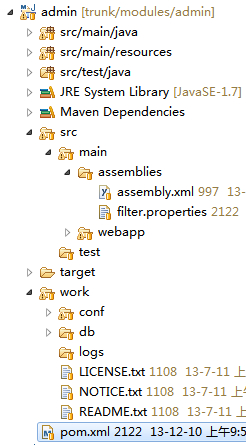开头的时候说过,能接触到maven,全赖boss的高明只见在项目中使用了。也亏得开明的boss甩给了我一周多的时间去了解和研究。程序员的行业,废话再多也抵不过真枪实弹,以下介绍一下我在项目中是如何使用maven的。
这个maven项目是一个有三个子系统,分别是admin、index和search。

图1 [项目总结构图]
我们首先分析一下图1:
build->存放构建生成的打包项目
core->存放核心代码项目
doc->存放项目文档的文件夹
modules->存放功能模块项目
*.bat ->构建项目包的脚本
其实,对maven来说,core或者modules中的项目均为module,只不过在我这个项目中就按照功能划分了一下而已。
先来看一下目录结构中的pom.xml,这个文件主要用来管理各个module
<?xml version="1.0" encoding="UTF-8"?>
<project xmlns="http://maven.apache.org/POM/4.0.0" xmlns:xsi="http://www.w3.org/2001/XMLSchema-instance"
xsi:schemaLocation="http://maven.apache.org/POM/4.0.0 http://maven.apache.org/xsd/maven-4.0.0.xsd">
<modelVersion>4.0.0</modelVersion>
<groupId>test.maven</groupId>
<artifactId>test</artifactId>
<version>2.1.60-SNAPSHOT</version>
<packaging>pom</packaging>
<profiles>
<!-- 全部模块 -->
<profile>
<id>all</id>
<modules>
<module>core/parent/pom.xml</module>
<module>core/core/pom.xml</module>
<module>core/wordsegment/pom.xml</module>
<module>core/queryprocessor/pom.xml</module>
<module>modules/index/pom.xml</module>
<module>modules/search/pom.xml</module>
<module>modules/admin/pom.xml</module>
</modules>
</profile>
<!-- index -->
<profile>
<id>index</id>
<modules>
<module>core/parent/pom.xml</module>
<module>core/core/pom.xml</module>
<module>core/wordsegment/pom.xml</module>
<module>modules/index/pom.xml</module>
</modules>
</profile>
<!-- search -->
<profile>
<id>search</id>
<modules>
<module>core/parent/pom.xml</module>
<module>core/core/pom.xml</module>
<module>core/wordsegment/pom.xml</module>
<module>core/queryprocessor/pom.xml</module>
<module>modules/search/pom.xml</module>
</modules>
</profile>
<!-- admin -->
<profile>
<id>admin</id>
<modules>
<module>core/parent/pom.xml</module>
<module>core/core/pom.xml</module>
<module>modules/admin/pom.xml</module>
</modules>
</profile>
</profiles>
</project>这个pom.xml有什么用?其最主要的作用就是在构建打包时分类构建。比如我只想单独构建admin模块,那我就可以双击运行build_admin.bat或者执行
mvn package -Padmin如此将不会影响到此打包过程中没使用到的module。
请注意<module>标记中使用到的是相对路径。
接下来要讲得是core/parent/pom.xml这个文件

图2
我们可以看到,parent下只有一个pom.xml文件,这个文件管理着项目中使用到的所有公用依赖包以及插件,由于pom.xml文件内容十分长,所以我只能省略许多重复的
<?xml version="1.0" encoding="UTF-8"?>
<project xmlns="http://maven.apache.org/POM/4.0.0" xmlns:xsi="http://www.w3.org/2001/XMLSchema-instance"
xsi:schemaLocation="http://maven.apache.org/POM/4.0.0 http://maven.apache.org/maven-v4_0_0.xsd">
<modelVersion>4.0.0</modelVersion>
<groupId>test.maven</groupId>
<artifactId>test-parent</artifactId>
<packaging>pom</packaging>
<version>2.1.60-SNAPSHOT</version>
<properties>
<!-- 主要依赖库的版本定义 -->
<test.maven.version>${project.version}</test.maven.version>
<!-- Plugin的属性定义 -->
<project.build.sourceEncoding>UTF-8</project.build.sourceEncoding>
</properties>
<!-- 打包私服URL -->
<distributionManagement>
<repository>
<id>releases</id>
<url>http://192.168.8.181:9981/nexus/content/repositories/releases</url>
</repository>
<snapshotRepository>
<id>snapshots</id>
<url>http://192.168.8.181:9981/nexus/content/repositories/snapshots</url>
</snapshotRepository>
</distributionManagement>
<!-- 预定义依赖项的version,scope与exclusions,子项目中只需定义groupId 和 artifactId 即可 -->
<dependencyManagement>
<dependencies>
<!-- modules begin 项目中依赖到的其他项目模块 -->
<dependency>
<groupId>test.maven</groupId>
<artifactId>core</artifactId>
<version>${test.maven.version}</version>
</dependency>
<dependency>
<groupId>test.maven</groupId>
<artifactId>queryprocessor</artifactId>
<version>${test.maven.version}</version>
</dependency>
....................................................................
....................................................................
....................................................................
<!-- google -->
<dependency>
<groupId>com.google.guava</groupId>
<artifactId>guava</artifactId>
<version>15.0</version>
<scope>compile</scope>
</dependency>
</dependencies>
</dependencyManagement>
<!-- 插件配置 -->
<build>
<pluginManagement>
<plugins>
<!-- compiler插件, 设定JDK版本 -->
<plugin>
<groupId>org.apache.maven.plugins</groupId>
<artifactId>maven-compiler-plugin</artifactId>
<version>3.1</version>
<configuration>
<source>1.7</source>
<target>1.7</target>
<encoding>${project.build.sourceEncoding}</encoding>
<showWarnings>true</showWarnings>
</configuration>
</plugin>
.........................................................
.........................................................
.........................................................
<!-- eclipse插件,设定下载Source并屏蔽.svn文件 -->
<plugin>
<groupId>org.apache.maven.plugins</groupId>
<artifactId>maven-eclipse-plugin</artifactId>
<version>2.9</version>
<configuration>
<sourceExcludes>
<sourceExclude>**/.svn/</sourceExclude>
</sourceExcludes>
<downloadSources>true</downloadSources>
<downloadJavadocs>false</downloadJavadocs>
</configuration>
</plugin>
</plugins>
</pluginManagement>
</build>
</project><dependencyManagement>标记中管理了所有用到的依赖包,明确定义了用到的依赖包的版本
<pluginManagement>中标记了用到的插件,并为一些插件设定了部分统一配置,如maven-compiler-plugin插件中的JDK版本设定为1.7
我们再看module中是怎么使用这个parent的pom.xml的,例如queryprocessor的pom.xml
<project xmlns="http://maven.apache.org/POM/4.0.0" xmlns:xsi="http://www.w3.org/2001/XMLSchema-instance"
xsi:schemaLocation="http://maven.apache.org/POM/4.0.0 http://maven.apache.org/xsd/maven-4.0.0.xsd">
<modelVersion>4.0.0</modelVersion>
<!-- 集成parent的pom.xml -->
<parent>
<groupId>test.maven</groupId>
<artifactId>test-parent</artifactId>
<version>2.1.60-SNAPSHOT</version>
<relativePath>../parent/pom.xml</relativePath>
</parent>
<artifactId>queryprocessor</artifactId>
<packaging>jar</packaging>
<dependencies>
<!-- 应用项目中的其他项目,看见没,这里没有写版本号!因为parent中写了 -->
<dependency>
<groupId>test.maven</groupId>
<artifactId>wordsegment</artifactId>
</dependency>
<!-- lucene 引用依赖包也没有写版本号,parent中的依赖包管理已经写好了-->
<dependency>
<groupId>org.apache.lucene</groupId>
<artifactId>lucene-queries</artifactId>
</dependency>
....................................................................
....................................................................
....................................................................
<!-- test -->
<dependency>
<groupId>junit</groupId>
<artifactId>junit</artifactId>
<scope>test</scope>
</dependency>
</dependencies>
<build>
<finalName>test-${project.artifactId}-${project.version}</finalName>
<plugins>
<!-- compiler插件 这里也没有写版本号,更没有写配置,这个项目使用的就是jdk1.7,maven3默认使用的是jdk1.6-->
<plugin>
<groupId>org.apache.maven.plugins</groupId>
<artifactId>maven-compiler-plugin</artifactId>
</plugin>
....................................................................
....................................................................
....................................................................
<!-- dependency插件 -->
<plugin>
<groupId>org.apache.maven.plugins</groupId>
<artifactId>maven-dependency-plugin</artifactId>
</plugin>
</plugins>
</build>
</project>从上面的pom.xml可以看到,依赖包以及插件的配置中,已经不再写版本号了,插件中也可以默认使用parent中的配置。
最后面讲讲怎么把项目打包到build文件夹中
例如admin项目中,用到了打包插件maven-assembly-plugin
写贴上admin项目的目录结构图

图3
<!-- assembly插件 -->
<plugin>
<groupId>org.apache.maven.plugins</groupId>
<artifactId>maven-assembly-plugin</artifactId>
<executions>
<execution>
<id>assembly:admin</id>
<phase>package</phase> <!-- 绑定在打包阶段 -->
<goals>
<goal>single</goal>
</goals>
</execution>
</executions>
<configuration>
<finalName>${project.artifactId}</finalName>
<outputDirectory>target/assembly</outputDirectory> <!-- 打包后,目标输出的文件夹 -->
<filters>
<filter>${basedir}/src/main/assemblies/filter.properties</filter> <!-- 存放需要替换的变量的值,比如执行脚本中有个${VersionID},根据filter里的值能替换成对应的 -->
</filters>
<descriptors>
<descriptor>src/main/assemblies/assembly.xml</descriptor> <!-- 打包的详细配置文件 -->
</descriptors>
</configuration>
</plugin>再来看看assembly.xml是怎么处理的
<?xml version="1.0"?>
<assembly
xmlns="http://maven.apache.org/plugins/maven-assembly-plugin/assembly/1.1.2"
xmlns:xsi="http://www.w3.org/2001/XMLSchema-instance"
xsi:schemaLocation="http://maven.apache.org/plugins/maven-assembly-plugin/assembly/1.1.2 http://maven.apache.org/xsd/assembly-1.1.2.xsd">
<id>distribution</id>
<formats>
<format>dir</format><!-- 这里是有多种打包方式的,常用的有:zip、tar、tar.gz、dir、war、jar -->
</formats>
<includeBaseDirectory>false</includeBaseDirectory>
<!-- 需要装配copy的文件 -->
<fileSets>
<!-- 说明文件 -->
<fileSet>
<directory>work</directory>
<outputDirectory>/</outputDirectory>
<filtered>false</filtered>
<includes>
<include>*.txt</include>
</includes>
</fileSet>
<!-- 配置文件 -->
<fileSet>
<directory>work/conf</directory>
<outputDirectory>/conf</outputDirectory>
<filtered>true</filtered>
</fileSet>
<!-- database.sql文件 -->
<fileSet>
<directory>work/db</directory>
<outputDirectory>/db</outputDirectory>
<filtered>false</filtered>
</fileSet>
<!-- 日志文件 -->
<fileSet>
<directory>work/logs</directory>
<outputDirectory>/logs</outputDirectory>
<filtered>false</filtered>
</fileSet>
</fileSets>
</assembly>到这里,构建出来的文件被放入到了target/assembly这个目录中,剩下的就是build_admin.bat的工作了
@echo off
echo [info] 确保默认JDK版本为JDK7.0及以上版本,已配置JAVA_HOME.
set MVN=mvn
set MAVEN_OPTS=%MAVEN_OPTS% -XX:MaxPermSize=128m
echo MAVEN命令:%MVN%
echo ---------------------------------------------------------------------------------
echo * [Step 1] 开始编译并打包admin工程 *
echo ---------------------------------------------------------------------------------
call %MVN% clean install -Padmin -Dmaven.test.skip=true
if errorlevel 1 goto error
echo ---------------------------------------------------------------------------------
echo * [Step 2]admin工程打包成功 ,放入对应的build目录 *
echo ---------------------------------------------------------------------------------
set time_hh=%time:~0,2%
if /i %time_hh% LSS 10 (set time_hh=0%time:~1,1%)
set currentTime=%date:~,4%%date:~5,2%%date:~8,2%_%time_hh%%time:~3,2%%time:~6,2%
set filename=admin_%currentTime%
rem echo %filename%
echo 开始创建build目录
md build\%filename%
xcopy modules\admin\target\admin.war build\%filename%\.
xcopy /e /s modules\admin\target\assembly\admin-distribution build\%filename%\.
echo ---------------------------------------------------------------------------------
echo * [Step 3] 开始清除操作 *
echo ---------------------------------------------------------------------------------
call %MVN% clean -Padmin -Dmaven.test.skip=true
if errorlevel 1 goto error1
echo ---------------------------------------------------------------------------------
echo * 清除操作成功 *
echo ---------------------------------------------------------------------------------
goto end
:error
echo "编译打包失败,有错误发生"
goto end
:error1
echo "清除失败,有错误出现"
goto end
:end
pause通过执行这脚本将target/assembly里的文件搬运到build中,完整的构建包就出来了,然后就可以交付给其他部门使用了!






















 91
91

 被折叠的 条评论
为什么被折叠?
被折叠的 条评论
为什么被折叠?








